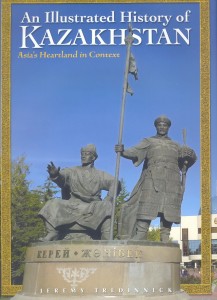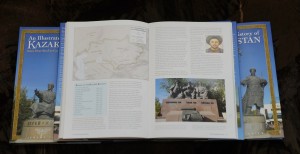ASTANA – A new book edited by Hong Kong-based writer Jeremy Tredinnick collects essays, photographs, maps, artefacts and other visual and textual information to illuminate the historical passage of the many cultures and peoples that have called Kazakhstan home.
 “An Illustrated History of Kazakhstan: Asia’s Heartland in Context,” to be released by Hong Kong’s Odyssey Books and Maps in November, tackles the immense task of tracing the history of a territory that has been “a crossroads for human migration around the world” since the Stone Age, according to its essay on Kazakhstan’s pre-history by scholars Zhaken Taimagambetov and Jean-Marc Deom.
“An Illustrated History of Kazakhstan: Asia’s Heartland in Context,” to be released by Hong Kong’s Odyssey Books and Maps in November, tackles the immense task of tracing the history of a territory that has been “a crossroads for human migration around the world” since the Stone Age, according to its essay on Kazakhstan’s pre-history by scholars Zhaken Taimagambetov and Jean-Marc Deom.
“Telling the ‘story’ of Kazakhstan through the ages illustrates its many significant roles in human history: it served as a fulcrum for early human migration throughout Eurasia and the wider world; it was one of the most important centres of bronze metallurgy during the Bronze Age; its steppes were the crucible for Iron Age nomadic warrior societies that would change the world order; and its bustling southern cities were vital links along the many trade routes of the classical Silk Road of antiquity,” the book begins.
Perhaps one of the most significant periods for Kazakhstan today that the book addresses is the rise of the Kazakh Khanate, described in the book as having formed over 300 years between the 15th and 17th centuries. In 1459, the sultans Kerei and Janibek, along with allied tribes, split with the Uzbek state of Khan Abulkhair and moved east to find lands of their own, eventually establishing a khanate that covered much of present-day Kazakhstan. Next year, the country will mark 550 years of statehood.
“Kerei and Janibek founded the Kazakh khanate in 1465,” President of Kazakhstan Nursultan Nazarbayev noted at an Oct. 22 gathering with the officials of the Astana city administration. “Today, our country preserves the traditions of centuries-old friendship and peaceful coexistence with all neighbouring countries. We should preserve these relations forever,” he said.
Meruyert Abusseitova, director of the National Information Centre for the Study of Historical Materials of the Suleimenov Institute of Oriental Studies of Kazakhstan’s Ministry of Education, who contributed the book’s essay on the rise of the Kazakh Khanate, writes that its origins can be traced back even further, and that the split only cast a spotlight on ongoing social, economic and political developments within the territory of modern-day Kazakhstan.
Next year’s anniversary approaches at a time when territorial sov ereignty in the region has become a source of renewed interest both within the region and beyond. Kazakhstan’s northern neighbour and major trading partner, Russia, recently weighed in on Kazakhstan’s narrative of its own statehood, with President Vladimir Putin suggesting that President Nursultan Nazarbayev “created a state on a territory where there has never been a state,” on Aug. 29 at the Seliger National Youth Forum. “The Kazakhs never had a state of their own, and he created it. In this sense, he is a unique person on the post-Soviet space and in Kazakhstan,” Putin said.
ereignty in the region has become a source of renewed interest both within the region and beyond. Kazakhstan’s northern neighbour and major trading partner, Russia, recently weighed in on Kazakhstan’s narrative of its own statehood, with President Vladimir Putin suggesting that President Nursultan Nazarbayev “created a state on a territory where there has never been a state,” on Aug. 29 at the Seliger National Youth Forum. “The Kazakhs never had a state of their own, and he created it. In this sense, he is a unique person on the post-Soviet space and in Kazakhstan,” Putin said.
The statement sparked a major discussion in Kazakhstan’s media, prompting Russian Ambassador to Kazakhstan Mikhail Bocharnikov explain that that statement was made as a compliment to the achievements of the 22-year-old country as a newly independent state.


